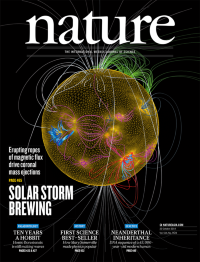Ver ítem
- xmlui.general.dspace_homeCentros e Institutos de InvestigaciónCICVyA. Centro de Investigación en Ciencias Veterinarias y AgronómicasInstituto de BiotecnologíaArtículos científicosxmlui.ArtifactBrowser.ItemViewer.trail
- Inicio
- Centros e Institutos de Investigación
- CICVyA. Centro de Investigación en Ciencias Veterinarias y Agronómicas
- Instituto de Biotecnología
- Artículos científicos
- Ver ítem
Pre-columbian mycobacterial genomes reveal seals as a source of new world human tuberculosis
Resumen
Modern strains of Mycobacterium tuberculosis from the Americas are closely related to those from Europe, supporting the assumption that human tuberculosis was introduced post-contact1. This notion, however, is incompatible with archaeological evidence of pre-contact tuberculosis in the New World2. Comparative genomics of modern isolates suggests that M. tuberculosis attained its worldwide distribution following human dispersals out of Africa during the
[ver mas...]
Modern strains of Mycobacterium tuberculosis from the Americas are closely related to those from Europe, supporting the assumption that human tuberculosis was introduced post-contact1. This notion, however, is incompatible with archaeological evidence of pre-contact tuberculosis in the New World2. Comparative genomics of modern isolates suggests that M. tuberculosis attained its worldwide distribution following human dispersals out of Africa during the Pleistocene epoch3, although this has yet to be confirmed with ancient calibration points. Here we present three 1,000-year-old mycobacterial genomes from Peruvian human skeletons, revealing that a member of the M. tuberculosis complex caused human disease before contact. The ancient strains are distinct from known human-adapted forms and are most closely related to those adapted to seals and sea lions. Two independent dating approaches suggest a most recent common ancestor for the M. tuberculosis complex less than 6,000 years ago, which supports a Holocene dispersal of the disease. Our results implicate sea mammals as having played a role in transmitting the disease to humans across the ocean.
[Cerrar]

Autor
Bos, Kirsten I.;
Harkins, Kelly M.;
Herbig, Alexander;
Coscolla, Mireia;
Weber, Nico;
Comas, Iñaki;
Forrest, Stephen A.;
Bryant, Josephine M.;
Harris, Simon R.;
Schuenemann, Verena J.;
Campbell, Tessa J.;
Majander, Kerrtu;
Wilbur, Alicia K.;
Guichon, Ricardo A.;
Steadman, Dawnie L. Wolfe;
Cook, Della Collins;
Niemann, Stefan;
Behr, Marcel A.;
Zumarraga, Martin Jose;
Bastida, Ricardo;
Huson, Daniel;
Nieselt, Kay;
Young, Douglas;
Parkhill, Julian;
Buikstra, Jane E.;
Gagneux, Sebastien;
Stone, Anne C.;
Krause, Johannes;
Fuente
Nature 514 : 494-497 (Agosto 2014)
Fecha
2014-08
Editorial
Springer Nature
ISSN
1476-4687
Formato
pdf
Tipo de documento
artículo
Palabras Claves
Derechos de acceso
Restringido
 Excepto donde se diga explicitamente, este item se publica bajo la siguiente descripción: Creative Commons Attribution-NonCommercial-ShareAlike 2.5 Unported (CC BY-NC-SA 2.5)
Excepto donde se diga explicitamente, este item se publica bajo la siguiente descripción: Creative Commons Attribution-NonCommercial-ShareAlike 2.5 Unported (CC BY-NC-SA 2.5)

